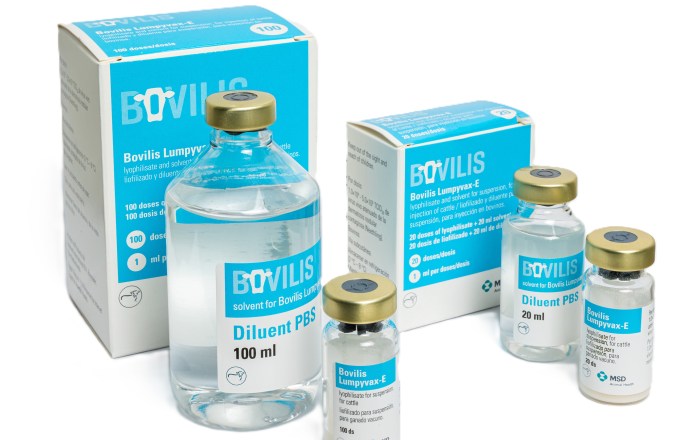Bovilis Lumpyvax-E

Composition
Each 1ml dose of vaccine contains Freeze dried pellet
Attenuated Lumpy skin disease virus (Neethling) 1.0 X 10⁴ – 5.0 X 10 ⁵ TCID₅₀
Target Species
Cattle
Healthy cattle should be vaccinated (e g., ideally before the outbreak season)
Calves born from vaccinated cows should be vaccinated from 4-6 months of age
Calves born from non-vaccinated cows may be vaccinated at any age.
Can be used during lactation and all stages of pregnancy.
Considering the recommendations of the World Organization for Animal Health
(WOAH) on vaccination against Lumpy skin disease (LSD):
-Newly purchased animals should be vaccinated 28 days before the introduction to the herd.
-Animals should be vaccinated 28 days before the transport or movement to another place.
– Same dosage and protocol should be applied to domestic buffaloes as for cattle.
-Annual vaccination of the adult cattle will protect animals from Lumpy skin disease.
Indications for use
For the prophylactic Immunization of cattle against Lumpy skin disease.
immunity starts to develop about 10 days after immunization and animal should be fully protected after 3 weeks (vaccine may not necessarily confer absolute immunity to all animals).
Annual revaccination.
Contraindications
None.
Special warnings
Vaccinate healthy animals only.
Do not use in cattle showing LSD skin lesions.
Vaccinated cows that develop an antibody response will confer maternal immunity to Lumpy skin disease by means of colostrum and this last for 4 to 6 months.
Maternal antibodies in calves may have an influence on the vaccine efficacy.
A small percentage of cattle are naturally immune to Lumpy skin disease virus and do not develop antibodies following vaccination. When this occurs, there is no colostrum antibody protection, and the calves of these cows may be at risk from an early age.
Although this vaccine has been extensively tested under a large variety of conditions, failure there may ensue for a wide range of reasons. If this is suspected seek veterinary advice and notify the registration holder.
Special precautions to be taken by the Person administering the veterinary medicinal product to animals.
It is good vaccination practice when handling the vaccine to avoid contact with the eyes, hands and clothing. In the case of accidental self-injection, wash the area immediately with water.
If symptoms develop seek medical attention showing a copy of the product literature.
Overdose
A slight transient rise in temperature may occur for 1-2 days, and a soft diffuse non painful
swelling at the injection site.
Major Incompatibilities
Do not mix with any other veterinary medicinal product.
Adverse events
Cattle
| Very rare (<1 animal / 10.000 animals treated, including isolated reports) | Temporary milk production decrease. Skin lump. Temporary hyperthermia. Injection site swelling. |
In regions in which lumpy skin disease is not endemic small lumps may occur, which
Usually resolve without treatment. Reactions if observed are mostly observed after the
Primary vaccination and very rarely seen after revaccination.
Dosage for each species, routes and method of administration
Reconstitute the lyophilizate with solvent provided for each pack size.
Administer 1 ml of the vaccine per animal by subcutaneous injection.
Advice on correct administration
Use sterile injection equipment. Free from traces of disinfectants. Use a sterile syringe to transfer approximately 5ml of sterile solvent to the bottle containing the freeze-dried vaccine. Mix until all the powder is dissolved and then transfer this Suspension back to the remaining sterile solvent and again mix well using the sterile syringe. Shake the bottle before filling the syringe.
Withdrawal periods
Meat: Zero days
Milk: Zero days
If required by national legislation another Withdrawal period may also be licensed.
Special storage precautions
Lyophilizate and solvent.
Store in a refrigerator (2°C – 8°C).
Protect from light.
Do not freeze.
Once reconstituted use within 8 hours.
Special precautions for disposal
Use take-back schemes for the disposal of any unused veterinary medicinal product or waste materials derived thereof in accordance with local requirements and with any applicable national collection systems.
Pack sizes
Lyophilizate glass type I closed with a butyl rubber stopper and sealed with an aluminum cap.
Solvent: PET vial sealed with a combination cap.
Pack sizes: Cardboard boxes with 20 or 100 doses of vaccine and solvent. Not all pack sizes may be marke
